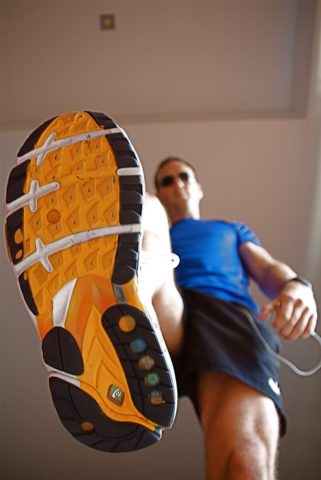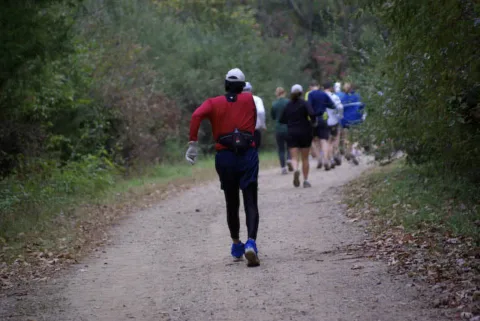So, you’re an ultrarunner — which means you run. Right?
You’re certainly not a walker. Walking is for walkers. Running is for runners. Pretty simple and straightforward. Right?
Wrong! Once you get past the marathon and 50-mile distance, most ultrarunners have to incorporate walking into their race strategy.
It’s true… 100-mile ultramarathons and timed races of 24, 36, 48 hours (and beyond) require a person to execute an effective run-walk plan.
Ultrarunners Learn This The Hard Way
Walking is typically seen as the soft option in running races. However in an ultra, walking is often the smart option.
In a hilly race, even the elite runners walk. The difference between them and the back-of-the-pack runners is the amount of walking and the speed at which they walk.
Some people have to learn this the hard way. They do a longer race with a run-only strategy and then self-destruct at some point and start walking out of necessity and survival. Not good!
The world is filled with DNF ultrarunners who went that route. The unfortunate part is if they had incorporated walking from the start, they could have covered several more miles than they did from their crash-and-burn default approach.
Do You Incorporate Walking In Your Training?
I remember the day I had coffee with 2015 Vol State 500k winner Greg Armstrong to discuss multi-day racing strategies.
The first thing he asked me was if I incorporated walking in my training. Busted!
At that point I thought of walking as something you just had to do when you couldn’t run any more. In my mind, walking meant failure. Walking was for losers. Wow, was I dumb!
While the run-only mentality might apply to the marathon or similar distances, walking is a key element to succeeding as an ultrarunner in the longer distances and multi-day races.
I want to plant a seed in your head with this article. If you aspire to running the longer distance ultramarathons, start walking!
To understand this, you first have to educate yourself:
There’s a reason why walking is useful in ultramarathons and it relates to energy efficiency and muscle fatigue. Running uses 70% of the body’s muscles. Those muscles get tired and need to rest. By switching technique, underutilized muscles can be engaged to shift the burden and allow the body a chance to recover. The simplest way to do this is to walk.
A Run-Walk Strategy For Ultrarunners
 There are different approaches to a run-walk strategy for long-distance ultramarathons.
There are different approaches to a run-walk strategy for long-distance ultramarathons.
It basically comes down to determining a run/walk ratio. For example:
- 25/5 – 25 minutes running, followed by 5 minutes walking
- 20/5 – 20 minutes running, 5 minutes walking
- 10/1 – 10 minutes running, 1 minute walking
- 5/1 – 5 minutes running, 1 minute walking
It’s typical that you get tired during a race and would need to adjust your run/walk ratio. For example, you might adjust a 25/5 strategy after awhile to something shorter — and it may even turn more into walking with running breaks.
In hillier races, it often is better to synchronize the walk breaks with the uphills. It doesn’t feel right if the clock says that you should walk a downhill and run an uphill. Better to improvise.
There are countless scenarios in terms of a run/walk ratio — which basically comes down to what feels best and works for you. The key is that you experiment and find what works for you by incorporating walking in your training.
You’ll discover that incorporating walking into your training will make for sore calves until you get used to it. WARNING: do not try a run/walk strategy for the first time on the day of your ultra!
If you plan on thriving and succeeding as an ultrarunner, particularly in the longer races (100+ miles; 24, 36, 48-hour timed races; multi-day races), you’re going to have to become skilled and effective at walking.
Before You Start A Run-Walk Program
Here are 3 final tips to get you going:
- Change your mentality about walking. Stop thinking about it as a sign of failure, defeat or being soft; start thinking about it as the key to your success.
- Incorporate walking into your training. Establish an effective training plan for becoming powerful and efficient in your walking.
- Use a run/walk strategy not as a last resort but from the beginning of your ultra. Use a sports watch with a timer that allows you to program your run/walk intervals. It’s important to remember that ultramarathon walking is not a leisurely stroll — it’s a brisk walk or racewalking. The idea isn’t to walk in order to slow down, but to alternate the movements you are using to move forward. Here’s a run/walk calculator to help you plan your strategy.
A well-planned run/walk strategy can:
- Extend the distance you can run considerably
- Prevent or postpone exhaustion, muscle cramps, and stomach issues
- Reduce the recovery time after a race significantly
If you haven’t tried it, you should. Start walking!





